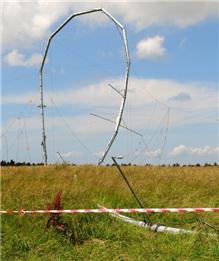England
Broken guy rope anchor blamed for mangled mast
By Martin Neville | Isle of Wight County Press | iwcp.co.uk 29 June 2012
By Martin Neville | Isle of Wight County Press | iwcp.co.uk 29 June 2012
This dramatic picture shows the mangled remains of a 70-metre meteorological mast at Camp Hill.
Partnerships for Renewables (PfR), which erected the mast last August to measure wind speeds at the site, said a broken guy rope anchor caused the mast to buckle earlier this month.

The remains of the meteorological mast in Parkhurst Forest that broke in the recent high winds. Picture by Peter Boam.
The developer, which wants to construct two 125m turbines on the edge of Parkhurst Forest, cordoned off the site early the next morning.
A spokesperson said: “The site is part of the prison with no public right of access so members of the public were not at risk.
“Events of this kind are extremely rare and we will be working closely with our contractor to establish how the breakage occurred.”
Despite being Ministry of Justice land, engineer and physicist Dr John Yelland, who lives in the forest and is against PfR’s plans, said the site was easily accessed by the public.
He said: “The fate of PfR’s 70m mast does not inspire us with confidence in its ability to safely oversee the erection of two 125m wind turbines.”
Meanwhile, the RSPB has objected to the scheme and called for more information on the potential impact on the protected nightjar species after one was killed after striking the mast last summer.
Dr Richard Black, conservation projects officer, said: “Nocturnal birds, including nightjar, are especially vulnerable to wind turbines near woodlands where they are more likely to fly high.
“The dead bird is a clear indication not only nightjar use the site but also they are vulnerable to collision with large structures.”
A PfR spokesperson said while the guy ropes of the mast were potentially difficult for birds to see, wind turbine towers were easily visible.
“The blades are not a significant risk to nightjar because the birds generally fly at heights well below the minimum sweep of the blades.
“Detailed ornithological studies, both of the forest edge and of the proposed site, have been carried out, concluding that the risk of collision (by nightjar) is deemed to be negligible and, therefore, no significant effect is predicted.”
“Natural England has stated it has no objection to the planning application on ornithological or ecological grounds.”
URL to article: https://www.wind-watch.org/news/2012/07/01/broken-guy-rope-anchor-blamed-for-mangled-mast/